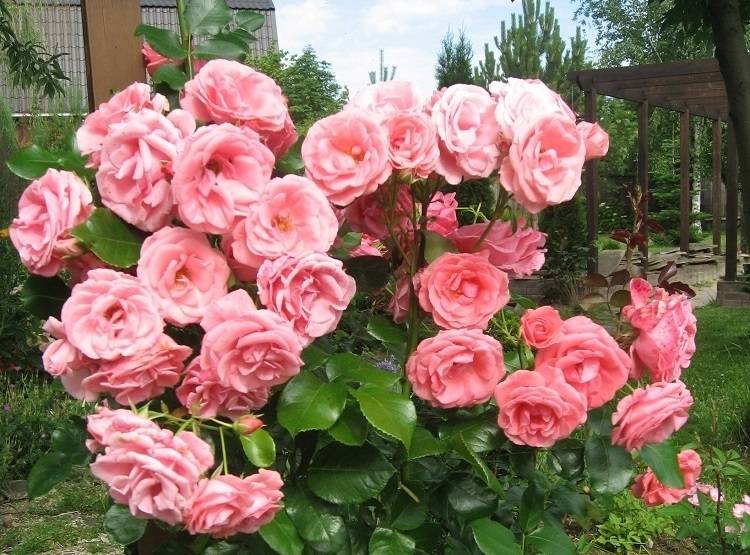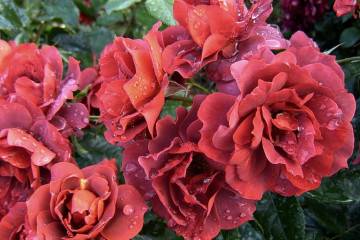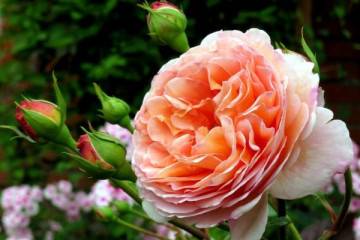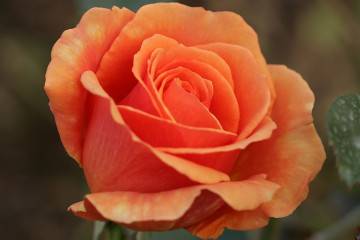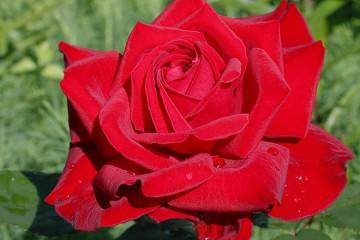Rose Lavinia (Lawinia) - description of a popular flower
Content:
Rose Lawinia, belonging to the group of climbers, is suitable for decorating the garden and keeps well in the cut. This plant is called one of the best climbing varieties of German breeding.
Rose Lavinia: description and characteristics
The variety known as the Avalanche rose, Lavinia, Lawinia, TANklewi, was obtained several decades ago. Today the flower is gaining more and more popularity in Russia.
The Lavinia bush can be grown as a scrub or as a climbing rose. The shoots are strong, they can reach 3 m in length. They are densely covered with leaves of rich green color. The buds are dense, bright pink, which are collected in penetrating clusters of 3-5 pcs. When the flower opens, a subtle fading is noted along the edge of the petals.
Lawinia goes well with coniferous crops, suitable for the formation of hedges and decoration of garden buildings. An adult bush goes well with small-flowered plants of white and purple buds.
How to properly plant in open ground and grow a flower
Climbing rose Lavinia will not cause trouble if high-quality planting material is planted in full compliance with the rules. The procedure consists of standard steps, but has its own nuances.
Lavinia can be planted in spring and autumn, but it is better to do this in May, when the threat of frost has passed. Young bushes planted before winter may not have time to take root until the cold weather.
Seat selection
Climbing rose Lawinia feels better in areas well-lit by the sun, protected from gusts of wind and drafts. The landing site should be on a small hill.
How to prepare the soil and flower for planting
The soil requires air and moisture permeability, nutritious, with neutral acidity. The soil must be dug up, adding sand and enriching it with organic matter.
Planting procedure step by step
Landing is carried out according to certain rules. The step-by-step procedure is as follows:
- Dig a planting hole 60 × 60 cm and a depth of 50 cm.
- Drainage is laid at the bottom of the pit and sprinkled with earth.
- The plant is lowered into a hole, the roots are carefully straightened.
- The pit is filled up, compacting the soil.
- The bush is watered with settled water.
- The soil around the rose is mulched.
After planting, a small canopy is created over the seedling for a couple of weeks, protecting it from direct sunlight.
Plant care
Problems in caring for a rose Lavinia can arise only if agricultural technology is violated. Compliance with standard agrotechnical procedures will allow you to get a healthy, abundantly flowering plant.
Watering rules and humidity
Water the plant regularly, but not too often, so as not to cause rotting of the root system. It is optimal to water once a week, followed by loosening the soil under the bush.
Top dressing and soil quality
They begin to feed the rose from the second year of life. At the beginning of the season, nitrogen is added to gain green mass, and from the moment budding begins, the bush is fertilized with phosphorus and potassium.
Pruning and replanting
When pruning, it is recommended to shorten the shoots with an amphitheater: the branches located closer to the support should be longer than the front ones. After wintering, dried and frozen parts of the bush, as well as root shoots, are removed.
A transplant is recommended only if there are serious reasons. Transplanting an adult climbing rose bush, its shoots are tied, removing all the buds and shortening them to 40-50 cm. Move the plant together with the earthen lump.
Features of wintering a flower
Before the onset of winter, dried leaves are removed from the lashes. After that, the shoots are tied up, laid on a bed of spruce branches, and fixed. Cover with non-woven fabric from above.
Blooming rose
Lavinia is distinguished by abundant and long flowering. An adult bush can bloom flowers in waves several times per season.
A period of activity and rest
The first buds appear at the end of May. Under favorable conditions, Lavinia will delight the gardener with flowers until the first frost.
What to do if it does not bloom
The main reason for the lack of flowering in Lavinia is a violation of planting conditions or the wrong choice of place. Also, one should not exclude the appearance of diseases or the attack of insect pests.
Flower propagation
The easiest way to propagate this rose is by layering. Thanks to the long flexible shoots, the process is carried out without unnecessary difficulties.
Layers are dropped in the spring, in May. They hibernate together with the mother bush under cover.
One of the shoots is bent to the ground and placed in a groove next to the bush. The branch is fixed, sprinkled with earth and during the summer, the level of humidity is monitored. With the arrival of spring heat, the sprouts are separated and transplanted.
Diseases, pests and ways to control them
Most often, Lavinia is annoyed by spider mites, aphids and thrips. They can be fought with folk remedies or insecticidal preparations.
When planting quality seedlings and following the care technique, the florist will not experience problems with Lavinia. A healthy shrub will bloom profusely, beautifying the garden throughout the season.
